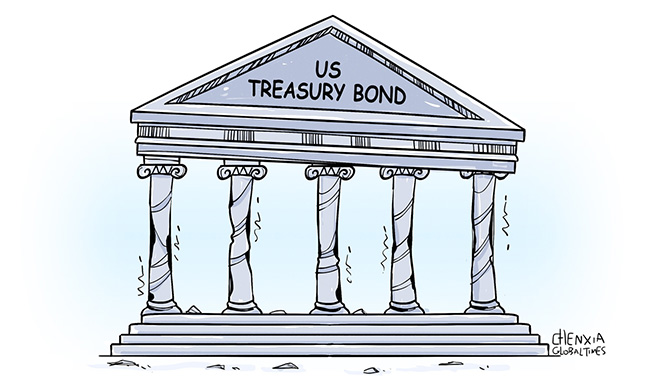Pic.: The Wall Street Journal
A selloff sparked by a hotter-than-expected inflation report intensified this past week after lackluster demand for a $39 billion sale of 10-year Treasuries. Investors also showed tepid interest in auctions for three-year and 30-year Treasurys, notes ‘The Wall Street Journal’.
Behind their caution lies a growing conviction that inflation isn’t fully tamed and that the Federal Reserve will leave interest rates at multidecade highs for months, if not years, to come. The 10-year yield—the benchmark for borrowing rates on everything from mortgages to corporate loans—finished the week around 4.5%, near its highest levels since touching 5% in October.
“There’s been a big shift in the market narrative. The CPI [consumer-price index] report changed everybody’s view of where Fed policy is headed,” said James St. Aubin, chief investment officer at Sierra Mutual Funds.
And issuance of Treasurys has exploded since the pandemic began. In the first three months of 2024, the U.S. sold $7.2 trillion of debt, the largest quarterly total on record. That surpasses the second quarter of 2020, when the government was financing a wave of Covid-19 stimulus. It also builds on a record $23 trillion of Treasurys issued last year, which raised $2.4 trillion of cash, after accounting for maturing bonds.
The size of the sales has expanded along with the market for U.S. debt. After poor demand at a series of auctions late last year jarred investors, the Treasury Department eased concerns by shifting to financing America’s deficit mostly with short-term debt. That helped, in part, because the Fed simultaneously signaled a pivot to easier monetary policy: Hopes that interest-rate cuts would come soon helped reassure investors about the Treasury’s strategy.
Now, those hopes are dwindling, and the Treasury is expected to announce its third-quarter borrowing plans at the end of April. The nonpartisan Congressional Budget Office forecasts that the deficit will increase from 5.6% of U.S. gross domestic product to 6.1% in the next decade. Debt held by the public is set to expand from $28 trillion to $48 trillion in that time, up from $13 trillion 10 years ago.
Wall Street doesn’t expect the Treasury to raise auction sizes of longer-term notes and bonds until next year. But the government must also contend with refinancing a chunk of its bonds. A record $8.9 trillion of Treasurys, roughly a third of outstanding U.S. debt, is set to mature just in 2024, according to Apollo Global Management’s chief economist, Torsten Slok.
Investors are also watching how revenues from tax season boost America’s coffers in the coming weeks.
“We’ve been losing liquidity as people and companies pull out money to pay taxes,” said Thomas Tzitzouris, head of fixed-income research at Strategas.
That leaves many investors hopeful that as long as inflation continues to trend toward the Fed’s 2% target, Treasury yields will remain under 5%. But some worry the influx of new Treasurys will exacerbate already-volatile markets, particularly if inflation stays sticky.
 Illustration: Global Times
Illustration: Global Times
Prices for gold – traditionally seen as a safe-haven asset – have been on an uptrend in the last few months, rising about 17 percent so far this year. Against such a backdrop, US Treasury securities may lose some of their safe-haven appeal if the yellow metal continues its historic rally.
Gold traditionally has an inverse relationship with US Treasury securities, as both are major safe-haven assets and therefore have a competitive relationship with each other. Overall, gold plays a crucial role in the global financial system, providing an alternative to assets denominated in US dollars, writes ‘The Global Times’ from China.
From the supply-side perspective, investors are widely expecting the US Treasury to soon announce an increase to its sales of long-term debt. As reported, the debt load of the US has grown at a quicker clip in recent months, increasing by about $1 trillion nearly every 100 days. US debt, which is the amount of money the federal government borrows to cover operating expenses, stood at about $34 trillion as of January.
When US federal government spending exceeds revenue, creating a budget deficit, the US covers the gap by selling securities, such as Treasury bonds. The past decades have seen an oversupply of these bonds. Now, the problem is even more serious.
Last year, ratings agency Fitch downgraded the US government's credit rating, citing fiscal deterioration over the next three years and repeated down-to-the-wire debt ceiling negotiations that threaten the government's ability to pay its bills.
The oversupply of Treasury bonds issued by the US government is a result of years of irresponsible fiscal policy. Such irresponsible policies and practices have exposed the global financial system to huge risks.
Over the past few years, the US experienced its most dramatic burst of inflation in four decades, as rising prices hit nearly every sector of the economy. The consumer price index rose 3.5 percent in March.
Stubborn US inflation has dented hopes for an imminent interest rate cut. As a result, some analysts believe gold will hit a new high as investors seek a hedge against stubborn inflation. With gold's rally, the demand for US Treasury securities is likely to continue to fall.
The role of US Treasury securities as the world's safe-haven asset has long benefited the US economy. It allows the US government to refinance debt easily.
But, as central banks start to diversify away from US Treasury securities and markets reassess their positions, the risk is that faith in US Treasury securities is shaken. Gold's rally may accelerate the process of a snowballing confidence collapse in US Treasury securities.
The world needs to be prepared for all outcomes, including the worst-case scenario, from the irresponsible US fiscal policy, ‘The Global Times’ stresses.
read more in our Telegram-channel https://t.me/The_International_Affairs

 12:23 17.04.2024 •
12:23 17.04.2024 •























